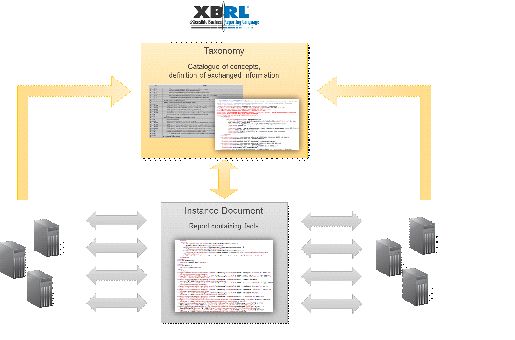European XBRL Reporting Entities handbook
From XBRLWiki
(diff) ←Older revision | Current revision | Newer revision→ (diff)
CEN Workshop Agreement
Status: Working Group Working Draft
Editing rules
Editorial comments should be highlighted as follows: A comment
Text or rules in discussion (white): Some text
Text or rules already aligned (green): Some text
Text or rules to be deleted (red): Some text
Text to be delivered (blue): Some text
Contents
|
Foreword
This document is a working document.
This document has been prepared by CEN/WS XBRL, the secretariat of which is held by NEN.
This document is a working document.
Introduction
Scope
The objective of this CWA is to provide a roll-out package for regulators who wish to use XBRL. More precisely, this CWA consists of two parts:
:i) An XBRL supervisory roll-out guide: this is oriented towards national regulators on how to implement, extend and manage XBRL taxonomies
:ii) An XBRL handbook for declarers: this is a roll-out guide or reference handbook would give a general introduction to XBRL and serve as a help to preparers of XBRL (reporting entities)
The scope of the current document is on the second part of the CWA; the XBRL handbook for declarers. In this general guide to XBRL, the following subjects will be addressed: [DRAFT]
Normative references
The following referenced documents are indispensable for the application of this document. For dated references, only the edition cited applies. For undated references, the latest edition of the referenced document (including any amendments) applies.
EN xyz:199x, Title of the european standard.
EN ab c:199x, General title of series of parts — Part c: Title of part.
Terms and definitions
For the purposes of this document, the following terms and definitions apply / the terms and definitions given in … and the following apply.
- Term1
- description on text for term1
- Term2
- description on text for term2
XML and XBRL: Introduction to its technological building blocks
This chapter aims to give an overview of the basic technologies that underpin XBRL. Our aim is to give a general introduction of each component in order to obtain a better understanding of this reporting language.
XML
According to the definition of the W3C, XML is a simple and flexible text format, simple and flexible, derivative of SGML. Although originally designed for the publication of information, XML is increasingly important in facilitating electronic communication as will be indicated further below.
Continue general definition of XML
XML as a markup language
Explains with simple examples how XML is made of tags
XML structures information
Explains XML's hierarchical structures
Components of an XML document
Explain XML elements, root node, and use of <? Xml version = "1.0" encoding = "UTF-8"> opening tag
Namespaces
Explain the use of namespaces: reason, URI, …
Namespaces and prefixes
Explain the use of prefixes (by further elaborating existing example)
UNICODE
Explain unicode
XML Benefits
Sum up and explain basic benefits of xml like; human-readable, self-containing, hierarchical structure, platform independent, …
XML Schemas
Introduce XML schema: definition of XML schema, why it is useful
XML Schema Components
Explain: types, attributes, groups of attributes and elements, importing and including schemas, substitution groups, …
Benefits of using XML Schema
Sum up benefits of XML Schema
XLink
Explain xlink
Technological components used by XML and by XBRL
XPath
Explain xpath
XSLT
Explain xslt
XQuery
Explain xquery
XBRL: Extensible Business Reporting Language
High level description
How to structure reporting data?
Before starting to explain XBRL, we would like to show via an example why the structuring of reported data can be useful. Reported financial data tend to be represented a table format. For example, the COREP Capital Adequacy table looks this:
Such a representation of information is very human-readable. However, it is not ideal for machine interpretation, as it is not very structured. As a result, the following question comes to mind: How can we structure this information, so that it can be transmitted and interpreted in a consistent way? For the purpose of this example, we’ll focus on the “Eligible Capital” line, which is highlighted in yellow in the above example.
A first step would be to tag the amount of Eligible Capital in a way that it is directly linked to the concept of Eligible Capital:
<p-ca:EligibleCapital>215</p-ca:EligibleCapital>
Although this information is already quite structured, some contextual information is missing. Information like the currency of the amount:
<p-ca:EligibleCapital unitRef=”EUR”>215</p-ca:EligibleCapital>
And finally, the reporting period:
<p-ca:EligibleCapital unitRef=”EUR” contextRef=”2012-12-31”>215</p-ca:EligibleCapital>
The above example shows, in a nutshell, how XBRL allows to structure reporting data.
XBRL Introduction
XBRL, or eXtensible Business Reporting Language, is a communication standard developed in order to simplify the exchange of business and financial data.
XBRL normalises the format of data (via the use of XML techniques) en the validation of data (via XBRL taxonomies).
ADD Explanation of the link between taxonomies and instance documents (as pictured above)
XBRL also provides among others:
- Standard validation rules (mathematical and logical rules)
- The use of label linkbases (which allows multi-lingual taxonomies)
- The possibility to provide rendering
- Standard toolset which allow to work with XBRL
During the following chapters we explain XBRL more elaborately. We try to give an insight in the following points: …
XBRL Taxonomies
XBRL taxonomy = "metadata" of reporting data. Taxonomies consist of schema's and relationships or linkbases
Schemas
The schema defines business conept (element of the schema) and basic attributes like: data type, period type, balance attribute, …
Linkbases
Explain linkbases like, label linkbase, presentation linkbase, definition linkbase, calculation linkbase
Extensibility
Taxonomy Extensions
Creating new relationships
Dimensions
The multidimensional model
XBRL dimensions
Formulas
XBRL Reporting: Instance documents
Explain with a practical example how an instance document is constructed…
Validation of XBRL reports
Describe the process of the validation of an instance document: xml validation, xml schema validation, xbrl validations, ….
Bibliography
- [1] :xxx
- [2] :xxx



